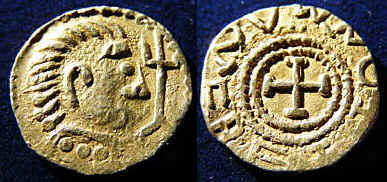

Onderstaande is het Romeinse voorbeeld

Roman Valentinian Gold Solidus Emperors Enthroned, Valentinian II gold solidus Two Emperors enthroned facing, holding globe between them, Victory standing on back of throne wings spread over Emperors heads [this is the prototype for the early Anglo-Saxon thrymsa Spink 767] present coin Old Sear 4148 in field T R below in exergue COM = Thessalonica mint a nice round coin evidently been in the ground as has slightly rough surfaces well centred no major problems gVF (US $839,95 (EUR 708,94) niet verkocht, 05-dec-05, ebay, lockdales-of-ipswich)
| Type munt | gouden tremessis | Omschrift voorzijde | Muntconditie | prachtig | |
| Provincie | Omschrift keerzijde | Datum | nov 2003 | ||
| Muntplaats | Voorzijde | Hoofd | Verkoper | Sodandk, Denemarken | |
| Jaartal | Keerzijde | 'twee keizers' | Bedrag | $923.00 Euro 850 gezien onderstaande munt is deze vals |
|
| Vorst | Vindplaats | November 2002, Oost Yorkshire, Carnaby | Veiling | ebay | |
| Metaal | goud | Schatvondst | |||
| Oplage | Literatuur referentie | Spink 767 (Metcalf 79-80, North 20) | |||
| Gewicht | 0,95 gram | ||||
| Diameter | 12 mm | ||||
| Soortelijke massa |
Zelfde muntstempel als SCBI Copenhagen 19
 |
Anglo Saxon gold thrymsa, this is a reproduction of an anglo-saxon gold
thrymsa C 630 AD. the obverse shows a radiate bust, the reverse shows victory protecting
'two emperors'. 12,56 mm, 13,05 mm, 0,91 gram Museum reproductions, no 173, 1 september 2006, euro 4,-- |
 |
You are bidding on a high quality handcrafted reproduction struck from the original coin. The coin is struck in silver and 22 karat gold plated. ANGLO-SAXON GOLD THRYMSA circa 680 AD The obverse shows a radiate bust. The reverse shows Victory protecting two Emperors. US $41,00 (EUR 31,60), 9 jan. 2005, ebay, antiquenovacoins |
 |
HERE FOR SALE IS A SUPER SAXON GOLD THRYMSAS GIVEN TO ME FROM MY
GRANDFATHERS COLLECTION 3 YEARS AGO. WUNEETTON TYPE.BUST R.,CROSS BEFORE.R.CROSS. BLUNDERED LEGEND (WVNEETON or SIMILAR) PLEASE FEEL FREE TO E-MAIL ME.FULL POSTAL INSURANCE OFFERED AND PLEASE NO PAY PAL. GBP 2.000,00 (EUR 2.530,18), niet verkocht, 26-jun-08, ebay, kflo74 |
 |
Anglo Saxon Gold Thrymsa Crondall type 620-645 bust R with trident, cross
with forked limbs and moneyer's name Seaby 767 US $1.425,00 (Ongeveer EUR 1.069,34), 5-mrt-05, ebay lockdales-of-ipswich Vals verklaart op http://www.forumancientcoins.com/fakes/ thumbnails.php?album=12 |
 Anglo-Saxon pale gold thrymsa Series D Post-Crondall type c655-675 A.D. 'Constantine' 'Oath-taking type' Spink 766 [see D.M. Metcalf Thrymsas and Sceattas in the Ashmolean Museum Oxford Vol. 1 pp47-49 Series VII for a scolarly discussion of this type]. Found South Walsham, Norfolk. The obverse of the present coin exhibits the die crack running from the cross to the thumb top evident with the Coddenham Suffolk finds [see J. C. Sadler Ipswich Numismatic Society Notes Vol XI 1990] and is possibly from the same die (I have sketches only to hand) The Coddenham coins shared the same obverse die and the British Museum specimen is from the same dies as one of these. Another Coddenham find exhibits a reverse as our present coin but hand and cross are replaced by a spiky object. The present reverse is interesting in that it doesn't have the crescent-like 'wings' which attach the 'standard' to the double pelleted inner circles. The cataloguer has a plaster squeeze of another thrymsa of this type in his cabinet which also exhibits this lack of crescents, but both dies seem different to the present. One other difference with the present reverse is that the 'mast-like' upright passes through the double pelleted inner circles. I have not attempted the legend but this seems yet another reading. The open hand is not gripping or holding the cross but is evidently placed flat against it (note the upright thumb) hence the symbolic oath to Christianity from at this time the probably semi pagan Anglo-Saxons. Almost certainly the product of an East Anglian mint. The coin is of great historical interest to early Anglo-Saxon England and is sold with all paperwork relivant to it to date. There are probably less than 15 of this type known and therefore is extremely rare. Weight 1.11g EF |
March 23, 2005 02:15 A RARE Anglo-Saxon coin, found by a metal detector
enthusiast, has fetched £3,456 (euro 5162,84) at an auction in Ipswich. The pale gold Thrymsa coin, which dates back to 655AD and is thought to be one of only 15 ever found, was bought at the 47th Lockdales of Ipswich auction held at the Novotel in Greyfriars Road. |
 |
Gold Tremissis. It has been fully recorded with the Early Medieval coin corpus at the Fitzwilliam museum: EMC number 2005.0102 (Ref: Reported) State: Early Continental (Merovingian Francia) (584-750), Ruler: anon. (tremissis) (590-670) Type: Merovingian tremissis (500-675) Mint uncertain (VVICO PONTIO), moneyer: Daculfus (DACVLFVS). Weight not recorded. Findspot: Barham, near Ipswich, Suffolk, England (TM 1451) Obv. INHVVICO PONTIO (H and V ligated, Ns reversed) Rev. +DACVLFVSMNT (S on its side) Source: Comments: Same dies as Prou 1120-1. The mint is 'Wico in Pontio', a lost wic site near Etaples in the Pas-de-Calais.` GBP 1.320,00 (EUR 1.954,60), 18-nov-05, ebay, norfolkwolf19228 |
 |
Early Anglo-Saxon Period (600-775), gold Thrymsa, in imitation of obsolete Roman coinage, Constantine-style head right, dnsevevspfnvg around, R. Crude Victory seated, vicraavvggg around, onob in exergue. Good very fine, holed in centre as usual for wearing, EXCESSIVELY RARE, POSSIBLY UNIQUE.(1) ***Found on the Downs in Hampshire early 1990s. GBP 630.00 (US $1,184.90 EUR 924,98 ), ebay live auctions, bloomsburyauctions |